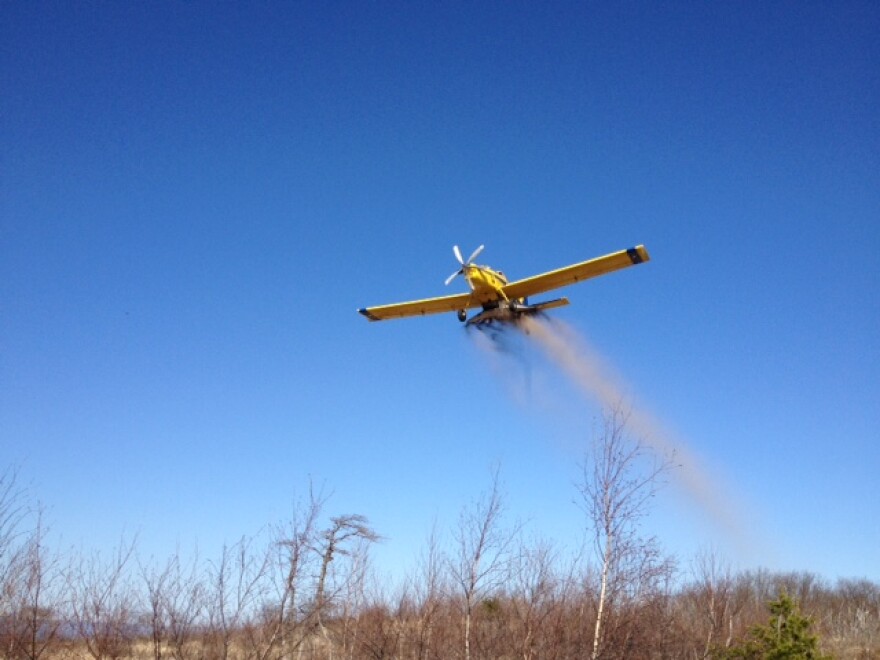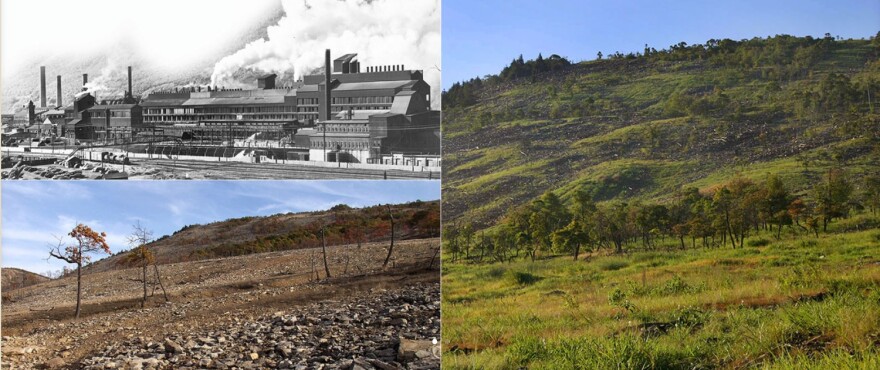SLATINGTON, Pa. — It’s been exciting, Chad Schwartz said, to watch Lehigh Gap Nature Center and the once-blighted land on which it sits, change over time.
“Having grown up in the area, I remember when the mountain was still barren, and driving through here with my family,” Schwartz, the nature center' executive director, said.
“I've heard lots of stories from family members and others about holding your breath when you drove through the Lehigh Gap because of all the pollution.
“So I've witnessed the transformation.”
- The Lehigh Gap Nature Center, situated on the Palmerton Zinc Pile Superfund Site, has been open for 20 years
- The center was part of an effort to restore land devastated by the zinc smelting operation
- After decades of remediation work, officials expect the site to soon enter a maintenance phase
The only nature center in the United States situated on a Superfund site, Lehigh Gap Nature Center this spring will celebrate its 20th anniversary.
A nonprofit with a mission to enhance habitats and protect wildlife, the center promotes conservation through education, research and outdoor recreation for all.
Through that work, the landscape has radically changed for the better, environmentalists said, making the Lehigh Valley a greener place.
Schwartz not only saw the transformation first-hand, but also participated. He’s been on staff since 2016, but got involved with the center through an environmental club five years earlier, when he was in high school.
“It's exciting for me this year to actually meet some of the people who are such a big part of that process early on,” he said.
“We have people from the EPA and one of our partners who helped make this possible back in the early 2000s, who are going to be coming back and celebrating with us.”
Becoming a superfund site
Blue Mountain, and about 3,000 acres around it, was unintentionally stripped of vegetation over about 100 years by the New Jersey Zinc Company.
The company set up a zinc smelting operation in nearby Palmerton in 1898, damaging the environment slowly over time.
Toxic heavy metals pumped from the factories' smokestacks decimated local vegetation. Then, sulfur gasses got into the clouds, forming acid precipitation. The acid rain pushed the nutrients out of the soil, and trees could no longer survive.
Less than five years after the zinc smelting operation shuttered in the 1980s, the site was added to the EPA’s Superfund National Priorities List — a catalog of sites that have been polluted or contaminated with hazardous chemicals.
Revegetation efforts began in the 1990s, with several rounds of seeding.
"We are the only nature center in the country on a Superfund site to this day," Schwartz said. "That is really what makes us stand out from other nature centers, so we try to incorporate that into a lot of what we do here."
That seeding still is happening, however, more rarely than decades ago.
At the end of March and beginning of April, pilots dropped a dozen species of native grasses, 25 species of wildflowers, pine and sumac seeds, as well as limestone and fertilizer, to encourage continued growth on the mountain through an aerial seeding initiative.
It was the first time the site was seeded in more than a decade.

‘We bought a Superfund site’
To mark the anniversary, the center in early April held a panel called Lehigh Gap Nature Center: A Conservation Success Story. Staff and board members gave presentations on the work that went into remediating the site, and answered questions from residents.
Marilyn Jordan visited the site for the first time in the late 1960s as a graduate student at Rutgers University, she said. It was part of a soil survey class.
“We walked on the east side, looking up and [we were] just aghast at what we saw,” Jordan said. “Dead stumps, rocks, rockslides, hardly any soil.”
She said she collected soil and studied the concentration of heavy metals close to and farther away from the smelting operation.
Seeds could not germinate in the soil, contributing to the land’s barren appearance.
Through testing, she said, she found the key change was to add limestone. With the additive, plants finally could grow.
Dan Kunkle, the center’s founding director, recounted the center’s beginnings as an organization called the Wildlife Information Center.
In 2001, leaders started talking about finding a place to build an environmental education center and thought of Lehigh Gap.
No organization in history ever bought a superfund site before, but we did.Dan Kunkle, the Lehigh Gap Nature Center's founding director
“I said, ‘What are you nuts? It’s a federal Superfund site, a toxic chemical site,’” Kunkle said.
He said he soon was convinced.
"Then we went to the board and they said, ‘What are you nuts? It's a superfund site.’ We convinced them.”
Goals included making it an education center, but in doing so, healing the land, replanting native species and working to stop erosion that deposited the heavy metal-laden soil in the Lehigh River.
“No organization in history ever bought a Superfund site before, but we did,” he said. “Our intention was to reclaim it.”
A story of hope
The center opened in 2003, and officials there have continued to use an ecological and collaborative approach to the land’s remediation.
Over time, native grasses took root and wildlife slowly began to return.
In September 2014, EPA Region 3 recognized the center with an Excellence in Site Reuse award for officials’ efforts to reuse a large part of the site as a wildlife preserve, promoting ecological conservation and education.
The next step for the site is to move past remediation and into a maintenance phase. While the timing of the transition is determined by the U.S. Environmental Protection Agency, leaders say they hope that will happen sooner rather than later.
Much of the work done and the community programming at the center is rooted in a story of transformation and hope, Schwartz said.
“There are a lot of environmental bad news stories in the world, and we try to set an example of what can happen,” he said.
“This is one of those instances where we had a very hopeless situation. We had 3,000 acres of land that was basically barren and lifeless. But we had this grassroots movement led by volunteers to revegetate the mountainside and create a community resource.
“Revegetating the mountainside was a big accomplishment, but also creating the space for the community to come together and learn was also a big part of that.”


